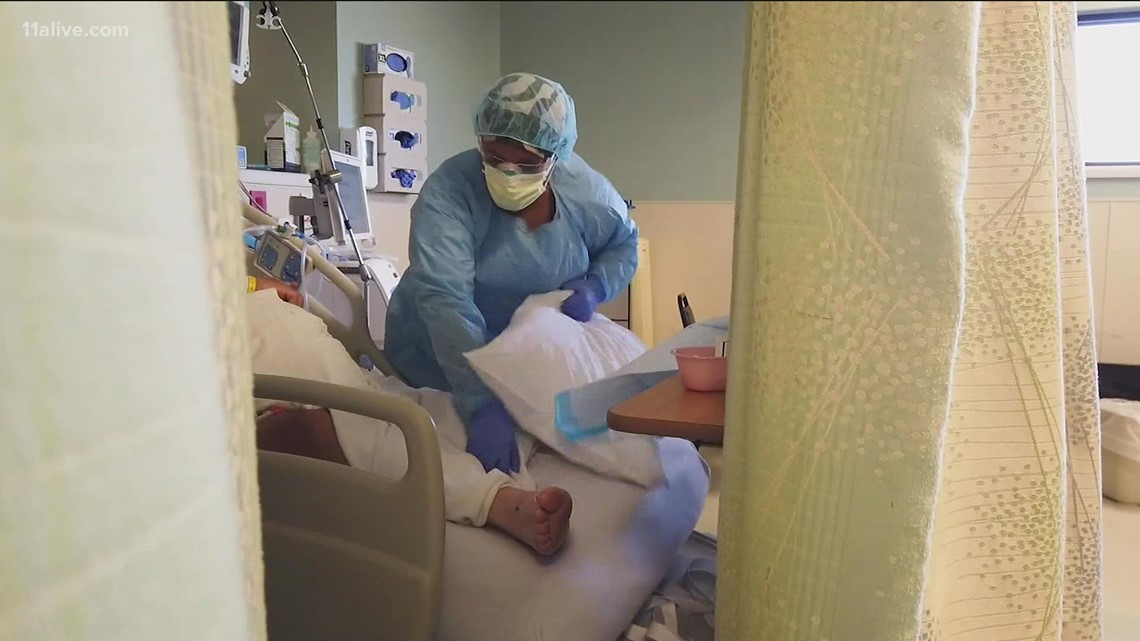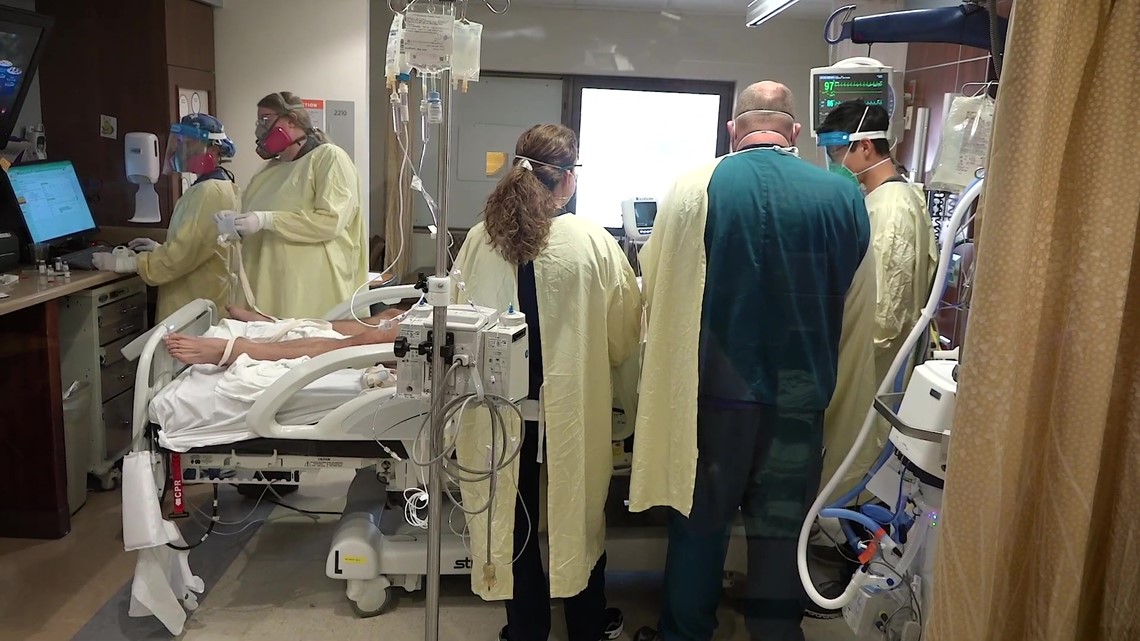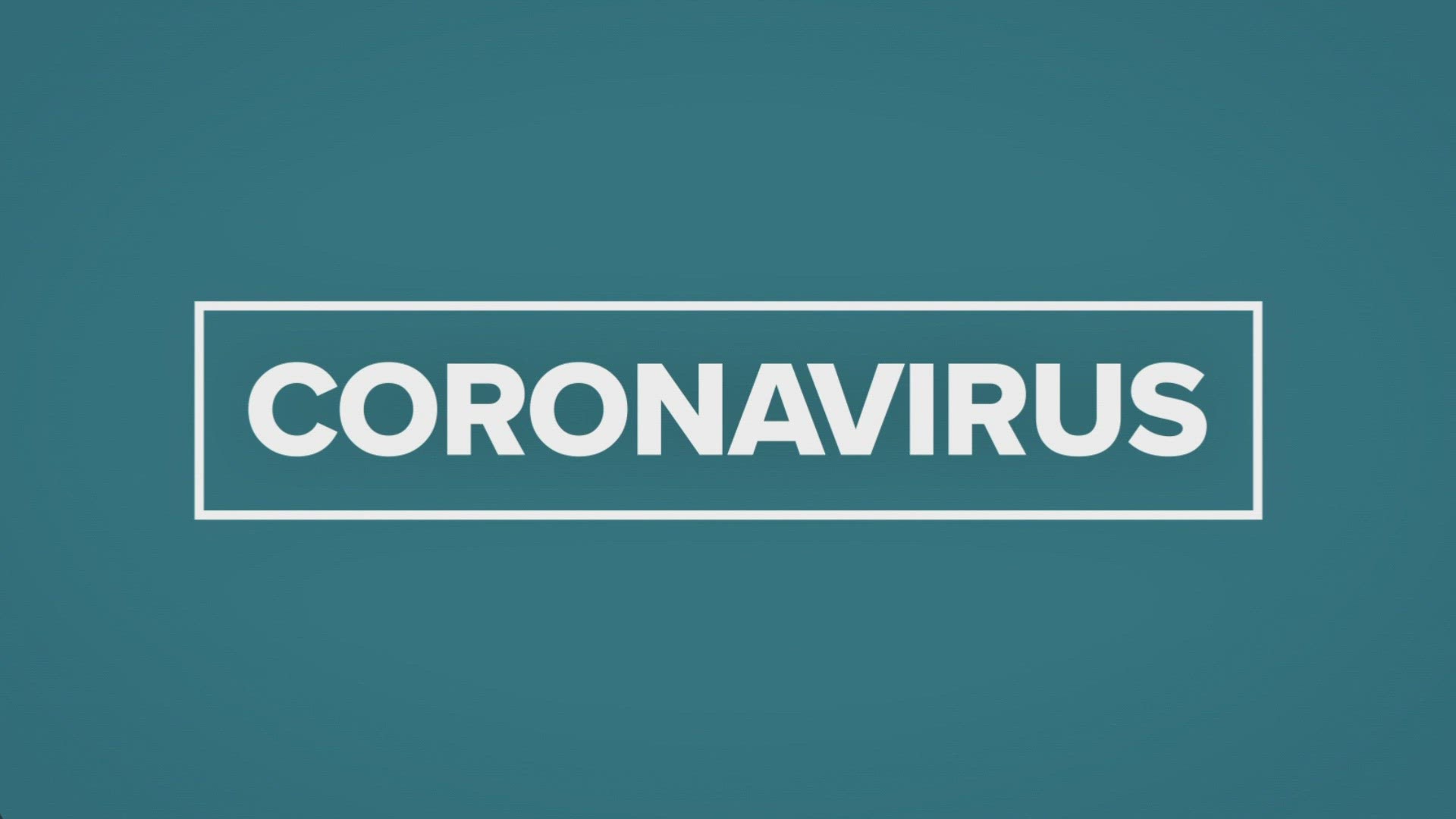NEW YORK — Hospital beds are continuing to fill up with mostly unvaccinated patients at record rates across the state.
As the state reports less than 10% of ICU beds are available, what does the bed situation look like at hospitals in your specific community?
An analysis of data released from the U.S. Public Health Service on Dec. 17, 2021 — the same week health organizations called the situation dire — shows disparities in ICU bed availability across the state.
In some cities, like Lafayette, there are just a handful of available ICU beds.
Indiana University Health Arnett Hospital reported 28 of their 29 ICU beds were full, and 171 of their 173 inpatient beds were occupied on Dec. 17. At Franciscan Health, 41 of the hospital’s 42 ICU beds were reported occupied.
ICU capacity at hospitals in cities within a 30 mile radius to Lafayette — Crawfordsville, Lebanon, Frankfort, Williamsport and Monticello — reported similar numbers.
Franciscan Health Crawfordsville hospital reported all five of their ICU beds were occupied. At Witham Health Services in Lebanon, 13 of 16 total ICU beds were occupied. Ascension St. Vincent in Williamsport reported five of their 16 beds were occupied. Indiana University - Frankfurt had one in-patient bed available.
But data experts caution ICU bed capacity is not the only distinguishing feature of a hospital's COVID readiness.
The ability to actually staff those ICU beds remains an essential component of how effectively hospitals can treat patients, which health experts told 13News is the main factor in how many ICU beds are actually available for sick people.
Staffing beds in ICUs
Adam Sacarny is an assistant professor of Health Police Management at the Mailman School of Public Health in New York. He analyzed data from 2016 to 2018, and found that hospitals reported approximately 93,000 ICU beds in the United States.
In total, there were about 3.6 ICU beds per 10,000 people, aged 16 and older, across the country. That average is higher in some communities that others — a discrepancy which plays out across Indiana.
Some cities, including Fort Wayne and Evansville, reported 6.1 ICU beds per 10,000 people. Lafayette had an average of 1.7 beds, while Indianapolis had an average of 5.3 beds.
However, Sacarny's research also showed hospitals with higher ICU bed capacities were not necessarily the most effective at treating patients needing their services.
"If you just focus on beds, and don't think about staffing, then you could find yourself in a situation where you have sufficient bed capacity, but you don't have sufficient staffing for the beds. It is a lot easier to measure the number of beds, and the number of people in the hospital currently, and the number of people in the hospital with COVID. It's harder to measure, 'Well, how many respiratory therapists can we call upon if we need it?'" Sacarny said.
In addition to data on ICU bed capacity, the U.S. Department of Health and Human Services releases reports on patient impact in relation to hospital capacity.
Those numbers give additional insight into how staffing shortages could exacerbate the problem of ICU bed shortages across Indiana.


A report released on Dec. 29 showed 23.6% of the state's hospitals — or 31 of 131 reporting hospitals — said they had faced a critical staffing shortage for that week.
One hundred Indiana hospitals reported no critical staffing shortages. Three did not report.
When asked about the week ahead, 27 Indiana hospitals said they expected to experience a critical staffing shortage, while 104 said they did not expect to face a critical staffing shortage.
DATA: The U.S. Department of Health and Human Services Reported Patient Impact and Hospital Capacity
ICU bed numbers alone also do not represent the full scale of how a strained a hospital is because what hospitals consider to be an ICU bed is sometimes in flux.
At the beginning of the pandemic in New York City, hospitals like New York Presbyterian Church quickly outfitted outpatient beds into ICU capable beds.
Hospitals in Indiana have that same capacity, to varying degrees.
"The actual number of ICU bed numbers at a hospital can change at any given time, as non-ICU beds can be turned into ICU beds with the right staff and equipment, and ICU numbers may fluctuate as patients move in and out of the ICU," said IU Health spokesperson Lisa Tellus, who also reiterated the number of available beds changes based on staffing levels.
In the early stages of the pandemic, when New York was an emerging global hotspot, it was easier for medical professionals from across the country to come in and assist. Now, with multiple hotspots continuing to percolate across the country, it is more difficult to find medical personnel to treat one area.
"If all the hospitals in the region are surging too, they're also calling on the same respiratory therapist and the same health care workers to come in," Sacarny said.
An exact ICU bed capacity count is further complicated by the reality that not all people who need treatment for COVID-19 at the hospital fall into neat, distinct categories of critical patients in need of ICU care and other.
At places like Hancock Memorial Hospital — where all ICU and inpatient beds were reported occupied in the latest U.S. Department of Health and Human Services report — Chief Nursing Officer Craig Fealty said there can be four types of patients to whom nurses can offer care.
Those consist of med/surge patients who are sick enough to be in the hospital but do not require an ICU-type setting. There are also patients in Progressive Care Units, who are one step down from an ICU patient, but still may require more advanced treatment than other patients.
Within that context, staffing issues can change who is taking care of whom within a hospital setting. Nurses normally called on for med/surge patients are tasked with taking on ICU patients.


"A med/surge nurse is trained to take medical surgical patients. They're not generally trained to take care of intensive care patients. So it's a different level of nursing," he said.
Throughout hospitals, a perfect ratio of one COVID patient to one nurse providing care in one I.C.U. bed does not often exist. Nurses generally care for several beds at once.
"On a med/surge unit, the nurse will have generally no more than four patients. But in our I.C.U., with me, with the mixed acuity we have, generally speaking we have a one-to-three to a one-to four-patient ratio," Featy said.
Moving forward amid omicron
The somber end result of these two variables, hospital staffing shortages capacity, plus decreased bed capacity, means Hoosiers in hospitals are not always receiving the level of care they need.
Hospitals are at a breaking point.
On Wednesday, Dr. Lindsay Weaver explained the current total hospital census is the highest it has been in five years.
"We're over 1,000 patients higher than we were last year," Weaver said.
Patients are being held in emergency rooms for hours — and sometimes days — until a bed is available.
"Patients are being cared for in hallways and waiting rooms," Weaver said.
To address this issue, the state health department has deployed six-person teams to dozens of hospitals to help with operations.
State leaders said they fear this is not enough, as fatigue within hospital staff is leading to widespread staffing shortages within the health care industry.
As thousands of eligible Hoosiers continue shunning the vaccine, it is an issue that will likely linger even if, as early data suggests, people do not get as sick with the omicron variant as they did with delta.
"If that trend continues, then really, it's not the level of ICU beds that we're going to need. Omicron still could easily overwhelm hospitals, because it could still fill up our beds with those individuals who need care, but they might not need ICU level care," Featy said.
The data analyzed by 13News for this story shows what ICU bed availability looked like at reporting hospital across Indiana as of Dec.17-23, 2021.
We've posted a few of the hospital ICU bed capacities in Indianapolis and central Indiana below. If you live in northern or southern Indiana, you can get a look at the ICU bed capacity situation at hospitals nearest you here.
Indianapolis Area Hospitals
Eskenazi Health – Indianapolis
343 of 384 total inpatient beds were in use as of Dec. 27, 2021.
96 of 121 ICU beds were in use.
*Eskenazi Health reported 71 COVID patients Wednesday afternoon. 30 occupied ICU beds, the rest were taken care of by other departments including the Emergency Department, according to 13News investigator Ciera Putnam.
Indiana University Health - Indianapolis
289 of 301 ICU beds were occupied.
IU Health West Hospital – Indianapolis
31 of 35 available ICU patient beds are occupied.
IU Health West Hospital has 139 of 141 inpatient beds occupied.
Community Hospital East – Indianapolis
51 of 80 total ICU beds were occupied, and 203 of 287 inpatient beds were occupied.
Ascension St. Vincent’s – Indianapolis
65 of 164 ICU beds occupied, 609 of 744 inpatient beds occupied.
Franciscan Health - Indianapolis
69 of 77 total ICU beds were occupied, 365 of 404 inpatient occupied.
Community Hospital North - Indianapolis
55 of 117 ICU beds are occupied. 233 of 366 inpatient beds are occupied.
Community Hospital South - Indianapolis
11 of 25 ICU beds are occupied. 137 of 200 inpatient beds are occupied.
Greater Central Indiana Hospitals
Ascension St. Vincent Heart Center – Carmel
58 of 70 total ICU beds occupied. 64 of 91 total inpatient beds are occupied.
Indiana University Health North Hospital – Carmel
16 of 17 ICU beds are occupied, just 1 is available. 89 of 94 inpatient beds are occupied.
Ascension St. Vincent Carmel – Carmel
12 of 33 ICU beds are occupied. 59 of 122 inpatient beds are occupied.
Fransiscan Health - Mooresville
All 7 ICU beds were full. 41 of 91 beds were occupied
Hendricks Regional Health – Danville
13 of 14 ICU beds were occupied, 97 of 124 inpatient beds were occupied.
Riverview Hospital - Noblesville
14 of 15 ICU beds were occupied. 87 of 133 inpatient were occupied.
Johnson Memorial Hospital – Franklin
8 of 10 ICU beds occupied, 39 of 64 inpatient beds occupied.
Hancock Regional Hospital
All of Hancock Regional’s 24 ICU beds were occupied.
All of Hancock Regional’s 45 ICU beds were occupied.
Ascension St. Vincent - Kokomo
9 of 10 ICU beds occupied
65 of 123 inpatient beds occupied.
Community Howard Regional Hospital - Kokomo
7 of 8 IUC beds were occupied. 59 out of 109 inpatient beds were occupied.
Reid Health - Richmond
26 of 30 ICU beds occupied. 203 of 231 occupied
Indiana University Health Ball Memorial Hospital - Muncie
52 of 53 ICU beds occupied. 271 of 271 inpatient beds occupied.
Henry County Memorial Hospital
28 of 30 ICU beds occupied, 47 of 62 inpatient beds occupied.
Marion General Hospital
15 of 15 ICU beds occupied, 93 of 93 inpatient beds occupied.
Indiana University Health Tipton Hospital - Tipton
16 of 17 inpatient beds occupied.
Union Hospital Inc. - Terre Haute
24 of 24 ICU beds occupied, 248 of 259 inpatient beds occupied.
Ascension St. Vincent Clay - Brazil
4 of 13 inpatient beds occupied
Terre Haute Regional Hospital - Terre Haute
13 of 21 ICU beds full. 69 of 221 inpatient beds full

